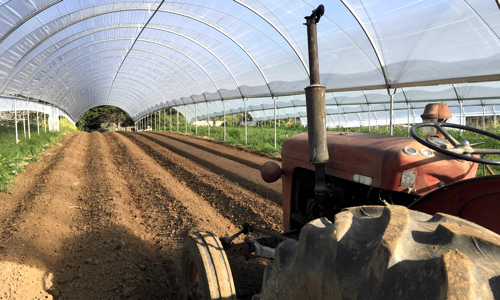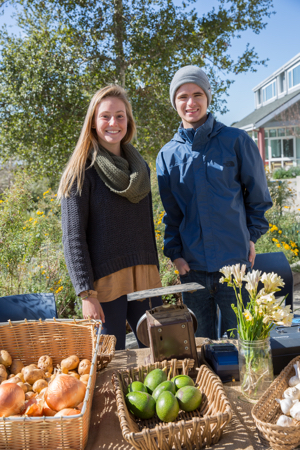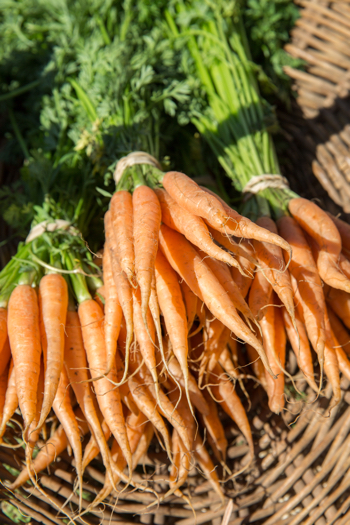Twenty-one-year-old Margaret Bishop stands at the edge of a plastic tunnel, warmth rising from the rich Elkhorn Sandy Loam soil at her feet. It’s a picturesque scene: winter-gnarled trees in the background and soft green lettuce seedlings stretching out in a long row next to beds planted with beets and spinach.
But this tunnel—one of four greenhouse-like structures—is also an important new step in UC Santa Cruz’s plan to help combat food insecurity, a problem faced by one in ten students, according to a 2016 UC systemwide report. The recently installed ag tunnels, or hoop houses, will allow the UC Santa Cruz Farm and Garden to provide a year-round supply of healthy, low-cost produce to dining halls, food pantries, and market pop-ups on campus. They are also at the center of a new focus for the Farm and Garden.
It’s an exciting development for Bishop (Kresge, ’18, sociology) who works 20 hours a week at the farm and also as the land-based co-chair of the campus Food Systems Working Group and who, just this morning, harvested 100 bunches of kale for the dining halls.
Not only will these hoop houses help provide students with a healthier option than ramen noodles during the entire school year, she says, but they may also help students develop an understanding of how food gets to the table—and also a taste for fresh, organic produce
“To find out the difference between a dried-out carrot shipped from the East Coast and a fresh carrot right out of the ground?” Bishop says. “Omigod.”
The problem of student food insecurity came to light in a 2016 UC study that found 19 percent of students reported they sometimes had gone hungry during the year. Another 23 percent said they had limited access to a variety of good-quality food because of a lack of money.
In California, according to the U.S. Department of Agriculture, 14 percent of households face food insecurity.
Experts point to rising costs and the high price of living in California as a reason why college students are going hungry or eating cheap junky alternatives. In Santa Cruz, which is one of the five least affordable cities for renters in the U.S. according to the National Low Income Housing Coalition, the cost of an undergrad living on campus for one year is $36,192. A student living off campus needs $32,685. For many, that doesn’t leave a lot of cash for a balanced, healthy diet.
This is where the UC Santa Cruz Farm is stepping in.
For much of its life, the campus’s 35-acre farm—used for research and teaching—sold its harvest at a market cart at the base of campus and to its Community Supported Agriculture (CSA) clients, who get weekly shares of fruits and vegetable for a yearly subscription fee.
But a push for the farm to create a deeper connection with the campus, along with a UC system pledge to make sure students have enough nutritious food to eat, set off a shift in direction.
Kirstin Yogg, who used to run a small farm on Santa Cruz’s north coast and is now field site production manager on campus, says the farm plans to cut the number of CSA customers from approximately 100 to 80 and also open the market cart only one day instead of two. This will allow more farm-raised produce to go directly to dining halls, to a pair of free food pantries that serve low-income students, and to twin pop-up farmstands on campus that provide a cheaper and easier way to get nutritious food.
The first pop-up, which began in 2015 at Quarry Plaza, was so popular a second site was launched at Rachel Carson College this January. Selling everything from kale to kiwi, the stands provide organic produce not only from the UC Santa Cruz Farm and Garden but also from two local farmers markets at about half the cost of what is found elsewhere—made possible by Global Food Initiative funding along with agreements worked out with local farmers markets, according to Tim Galarneau, UC Basic Needs co-chair. The Global Food Initiative is a UC systemwide program designed to address the problem of feeding a growing and hungry world.
Now, the 22-by–170-foot hoop houses, purchased along with seed with $27,000 in Global Food Initiative funding, mean students will have greater variety of veggies, especially during cold and rainy winters when choices were limited to things like potatoes and kale. The tunnels also add about a quarter acre of productive land to the farm. In fact, the first planting of about half of one hoop house will yield some 700 heads of lettuce and 200 pounds of spinach, according to Yogg.
Galarneau says money from the Global Food Initiative along with funds from AB453, the Hunger-Free Campus Act, also will be used to buy a 4X4 cart to help work-study students like Bishop harvest crops, to fund two new food storage containers, and to purchase an electric cart so produce can be delivered to food pantries and the pop-ups. A plan to have days when students can harvest their own fruits and vegetables also is in the works, along with surveys to find out exactly the kind of produce students want.
“This is an exciting new direction for us,” Yogg says. “A lot of staff are feeling energized by the shift in our focus. We will continue to supply produce to our longtime supporters but it’s fun to connect with students as well.”
For more information, visit the UCSC Basic Needs website.





